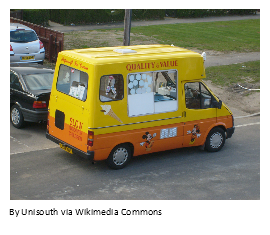 The other night I was meeting a friend for dinner in town. You know how sometimes when you get down to the tube platform it feels wrong? It felt wrong. Too many people, milling about with resigned looks, not purposefully waiting. Then the public announcement: “the Victoria line is suspended from Victoria to Walthamstow Central. There is a shuttle service operating between Brixton and Victoria.”
No train. No boards telling you when the next train is coming either. I have a choice: I can take the chance of waiting, hoping that if a train does come soon I might still be on time – but it might be ages; or I can go out and catch a bus – I will definitely be a bit late, but I know it will definitely come?
The other night I was meeting a friend for dinner in town. You know how sometimes when you get down to the tube platform it feels wrong? It felt wrong. Too many people, milling about with resigned looks, not purposefully waiting. Then the public announcement: “the Victoria line is suspended from Victoria to Walthamstow Central. There is a shuttle service operating between Brixton and Victoria.”
No train. No boards telling you when the next train is coming either. I have a choice: I can take the chance of waiting, hoping that if a train does come soon I might still be on time – but it might be ages; or I can go out and catch a bus – I will definitely be a bit late, but I know it will definitely come?
How do we deal with risk?
It’s a nice example of how we human beings deal with risk. I don’t know about you, but my thought process goes something like this. First I will take the higher risk option – perhaps partly because it is where I am. As I wait, and nothing happens, I weigh up how late I am going to be if I catch the bus. At some point (if I am still waiting) I decide to cut my losses – either way I’m going to be late, so I opt for the more certain course and catch the bus. This time, I waited 10 minutes before changing to Plan B, and was 20 minutes late. If I had changed immediately I would only have been 10 minutes late. It’s not very rational – the sensible thing surely is to take the low risk option as early as possible, minimising the lateness, rather than just hoping that Plan A will avoid us being late at all, and then finishing up being later than we needed to be. But it seems to be human nature to take the optimistic view like this. Usually when we have to deal with risk there is some kind of pain threshold we have to exceed before we are willing to consider an alternative course, even though the sensible point to do so may have been much earlier. I don’t know how much unnecessary pain we suffer as a result, but I suspect it is significant! Do you need help identifying the change options you have to deal with risk? Please get in touch. A few years ago, I spent a fascinating week travelling around Europe. I was trying to put together a consortium to bid for funding from an EU industrial research programme. I was selling a vision. It was one of those “if its Wednesday I must be in France” trips, where after a couple of days my brain’s language processor gets so confused it just gives up attempting anything except English. Fortunately (but as usual), my hosts all put me to shame by speaking excellent English to me.
This trip taught me a very important lesson about selling a vision which I have used many times since. No organisation wants to be the first to commit to partnering when all they have is an outline description of the objectives of the partnership. They feel they need to know who else will be a part of it, and what the content of the programme will look like. Without this, they don’t even really want to share their ideas of what they might contribute or what benefits they might receive. On the other hand, until they do share their ideas it is impossible to put together a realistic programme. So where do you begin?
I describe what I did as “Castles in the air”. Think of the project as a fairy-tale castle floating above the ground. You have to be able to describe in some detail what this castle looks like from a distance. Of course, no-one can actually get to it to look inside, so much of the detail does not need to be filled in, but the description has to be convincing enough that everyone believes it is a real castle, not an illusion. In particular, they must never think that there is nothing holding it up!
A few years ago, I spent a fascinating week travelling around Europe. I was trying to put together a consortium to bid for funding from an EU industrial research programme. I was selling a vision. It was one of those “if its Wednesday I must be in France” trips, where after a couple of days my brain’s language processor gets so confused it just gives up attempting anything except English. Fortunately (but as usual), my hosts all put me to shame by speaking excellent English to me.
This trip taught me a very important lesson about selling a vision which I have used many times since. No organisation wants to be the first to commit to partnering when all they have is an outline description of the objectives of the partnership. They feel they need to know who else will be a part of it, and what the content of the programme will look like. Without this, they don’t even really want to share their ideas of what they might contribute or what benefits they might receive. On the other hand, until they do share their ideas it is impossible to put together a realistic programme. So where do you begin?
I describe what I did as “Castles in the air”. Think of the project as a fairy-tale castle floating above the ground. You have to be able to describe in some detail what this castle looks like from a distance. Of course, no-one can actually get to it to look inside, so much of the detail does not need to be filled in, but the description has to be convincing enough that everyone believes it is a real castle, not an illusion. In particular, they must never think that there is nothing holding it up!
Selling a vision
Putting that into project terms, there has to be a clear vision of what the project could do, broadly who may be involved and how they will benefit, even though none of it is agreed, and you have to feel and sound confident about it, just in order to get people talking about how they might contribute. Once you can get possible contributors to engage, they will help you fill in the detail, adapt the vision and underpin it with the foundations, until the whole project is solid enough to stand up by itself. The same principles apply to any situation where you need to influence many different people to win their support for the same idea. Unless you can describe your “castle in the air” with confidence, as though it were real and solid, it will be very difficult to get a hearing at all. The more people listen and contribute, even if they are not yet fully convinced, the easier it gets to win over others. I have recently moved house. I moved from a small and very ordinary town in Oxfordshire to a bustling area of London. What a contrast! From largely white to multi-cultural, from sleepy to vibrant, from staid dormitory to entrepreneurial.
One of the big differences is shopping. In Oxfordshire, there was little choice but to buy all your groceries from one of the big supermarkets. When I first lived there, there were many butchers, greengrocers and bakers. Over the years they have all shut up shop, unable to compete with the demand for the convenience of "all I need under one roof" and "open when I get home from work", even if supermarket prices can be high. Here I am spoilt for choice, especially with butchers, fishmongers and greengrocers. What a delight to be able to wander up and down the stalls, with the noise of vendors shouting out offers, with the bright colours of peppers, tomatoes, oranges and lemons and the indefinable smells, looking for the freshest, the fattest, and (wishfully) the tastiest.
I have recently moved house. I moved from a small and very ordinary town in Oxfordshire to a bustling area of London. What a contrast! From largely white to multi-cultural, from sleepy to vibrant, from staid dormitory to entrepreneurial.
One of the big differences is shopping. In Oxfordshire, there was little choice but to buy all your groceries from one of the big supermarkets. When I first lived there, there were many butchers, greengrocers and bakers. Over the years they have all shut up shop, unable to compete with the demand for the convenience of "all I need under one roof" and "open when I get home from work", even if supermarket prices can be high. Here I am spoilt for choice, especially with butchers, fishmongers and greengrocers. What a delight to be able to wander up and down the stalls, with the noise of vendors shouting out offers, with the bright colours of peppers, tomatoes, oranges and lemons and the indefinable smells, looking for the freshest, the fattest, and (wishfully) the tastiest.
The right price
One thing though took me by surprise. The price of bananas. Most of the market fruit and vegetables are good value by comparison with the supermarkets. But bananas? I’d guess the market price is about double the price in supermarkets! What is the right price? What is going on? The big chains compete with each other, not with market traders. If one shop puts a price down, the others pretty much follow suit. If one decides that bananas are to be a loss-leader, probably the rest do too. And this sort of pricing is like a ratchet – if it becomes established, it is very hard to move it in the other direction. The supermarkets may paint themselves into a corner. Pricing matters – and not just because companies exist to make a profit. Price sends a signal about what something is worth. “You get what you pay for” as the saying goes. Paradoxically, you may get more people coming to an event for which they have to buy a ticket than will come to one that is free, because the free event is not valued. Needing an income, I once took a job which paid considerably less than I had previously been earning. Result? I got very bored because no-one thought to use my higher skills. I was pigeon-holed by my price, and I left as soon as I could. Pricing that does not match value may serve a necessary short term purpose, but in the end it serves no-one very well. The right price matters. Have you ever noticed how the crowds waiting for commuter trains at Paddington (or doubtless most other big terminus stations) nearly all stay on the concourse until the platform is announced, even though each train usually runs from the same platform every day (so the regular commuters who are the majority all know which it is likely to be)? Consequence – a great crush as everyone rushes at the ticket barriers at once.
Have you ever noticed how the crowds waiting for commuter trains at Paddington (or doubtless most other big terminus stations) nearly all stay on the concourse until the platform is announced, even though each train usually runs from the same platform every day (so the regular commuters who are the majority all know which it is likely to be)? Consequence – a great crush as everyone rushes at the ticket barriers at once.
Beating the crowd
There are always a small number of people who don’t wait. They go calmly through the barrier with no queues, and get seats exactly where they want, beating the crowd instead of risking no seat at all. Maybe once in a blue moon the platform is different and they have to move – but it’s rare. It’s a great illustration of how conformist people (or at least we Brits) tend to be. I would guess less than 5% make the rational risk-reward trade-off and act accordingly, beating the crowd. 95% of us prefer to be part of the herd – but I wonder whether it is the people you would expect? Now there’s an interesting way to separate the sheep from the goats! Given those proportions, it is hardly surprising that very few people embrace change before they have to – even if they would stand to benefit from being early adopters. On the other hand, as change managers we have no need to wait until everything is ready before making announcements, unlike station staff. Early communication leads to more organised loading! Such a simple question, but what a profound difference! A recent article in HBR [http://hbr.org/2013/03/do-you-play-to-win-or-to-not-lose/ar/1 ] shows that this aspect of personality can trump others when it comes to determining fit.
Such a simple question, but what a profound difference! A recent article in HBR [http://hbr.org/2013/03/do-you-play-to-win-or-to-not-lose/ar/1 ] shows that this aspect of personality can trump others when it comes to determining fit.
Play to win
‘Promotion-focussed’ people are comfortable with risk, dream big, and think creatively. They play to win – but in their haste and optimism they sometimes come unstuck because they fail to plan for the unexpected. On the other hand, those who are ‘Prevention-focussed’, and who plan carefully and pay attention to detail to make sure that nothing goes wrong, may be better at telling the good ideas from the bad, but are often uncomfortable if they cannot take the time to follow due process. Both types are needed, of course. Most people show some characteristics of both at different times, but most have a dominant focus. People will often find the preferences of someone with the opposite focus hard to understand. Where the relationship is important, this matters. When I shared this idea with a consultant friend, it gave her a new insight into what had happened in her relationship with a recent client. Although her experience had been an excellent fit with the client’s requirements, and she had therefore expected everything to go very smoothly, the engagement was terminated early with recriminations on both sides. Seen through the lens of this idea, my friend’s promotion-focussed style was always going to seem threatening to the prevention-focussed CEO, leading to attempts to constrain her activities – or, as she saw it, to stop her doing the job she had been engaged to do. So when you think about taking – or recruiting to – a new job, make sure you know which focus you have, and think how this fits with the person on the other side of the table. It’s about 5°C outside, and I’ve just heard the chimes of the ice-cream van. Yes, I know its nearly April, and the daffodils are trying to come out, but who would want to put a coat on and go and shiver in the road for five minutes, just to eat something … very cold?
It’s about 5°C outside, and I’ve just heard the chimes of the ice-cream van. Yes, I know its nearly April, and the daffodils are trying to come out, but who would want to put a coat on and go and shiver in the road for five minutes, just to eat something … very cold?

